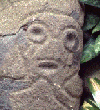free trial issue subscribe back issues
Some of the first historical accounts of the voyages of Columbus, Ojeda,
Cortes, and other Spanish explorers in the Americas were written by Peter
Martyr d'Anghera. This includes some of the earliest reports on New World
civilizations in
Mexico, Central,
and South America. Martyr was an Italian humanist from Florence who
served during the 1490s as tutor in the court of Ferdinand and Isabella,
and was later appointed the Spanish Royal Chronicler by Charles V. In these
posts, Martyr had direct access to the first Spanish explorers including
Columbus, Ojeda, Grijalva, and the pilot Alaminos. Besides personally
interviewing these explorers, he also saw the materials (ie., gold and trade
goods) they brought back to Spain from the New World, which greatly
impressed him.
[Fig.1: Map from Grijalva voyage in 1518 (Athena Review).]
First published between1511 and 1530, the accounts in Martyr's book De Orbe Novo remain of basic importance for understanding the first European contacts with native American civilizations. Originally written in Latin in eight Decades (groups of ten books each), Martyr's De Orbe Novo was first translated into English in 1555. A fuller version was translated into modern English in 1912 by Francis Augustus MacNutt, a scholar of the Spanish Colonial era in the Americas. A sample passage from Martyr (in McNutt's translation) may be seen describing the voyages of Ojeda along the coast of Columbia and Panama in 1499-1502.
Martyr's writings provide vivid and unique descriptions of the temples and
towns of the New World, before the
 native cultures
and institutions were displaced by the Spanish conquest. For example, the
Maya religious center at
Tulum, located on the east
coast of the Yucatán peninsula in Quintana Roo, was in active use
when Grijalva's 1518 expedition passed the coastline. Martyr describe coastal
cities seen by these voyagers along the coastline south of Cape Catoche.
Martyr is also the first to report the widespread cult of
zemi figures
used by the Taino tribes
in the Caribbean Islands, associated with household gods. Martyr's
informants sometimes also termed the figurines and religious statues on the
Mexican mainland as zemis.
native cultures
and institutions were displaced by the Spanish conquest. For example, the
Maya religious center at
Tulum, located on the east
coast of the Yucatán peninsula in Quintana Roo, was in active use
when Grijalva's 1518 expedition passed the coastline. Martyr describe coastal
cities seen by these voyagers along the coastline south of Cape Catoche.
Martyr is also the first to report the widespread cult of
zemi figures
used by the Taino tribes
in the Caribbean Islands, associated with household gods. Martyr's
informants sometimes also termed the figurines and religious statues on the
Mexican mainland as zemis.
[Fig 2: Zemi from the Taino culture of Puerto Rico, 1300-1500 AD (photo: Athena Review).]
Athena Review Image Archive™ | Paleoanthropology in the News | Guide to Archaeology on the Internet | Free issue | Back issues
Main index of Athena
Review |
Subject Index
| Travel
Pages |
Galleries and
Museums |
Copyright © 1996-2001 Athena Publications, Inc. (All Rights Reserved)